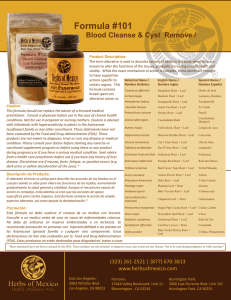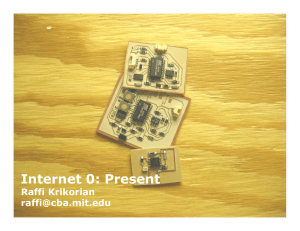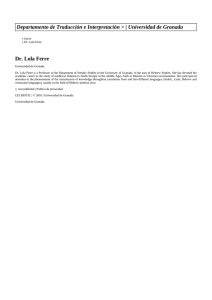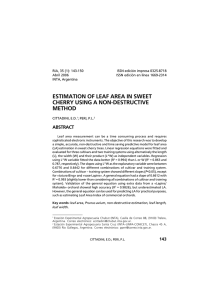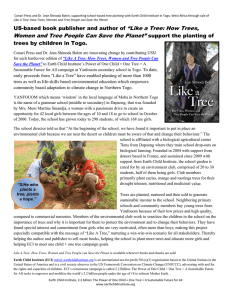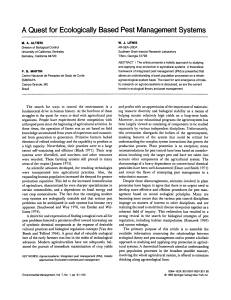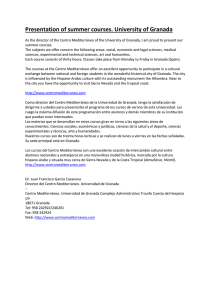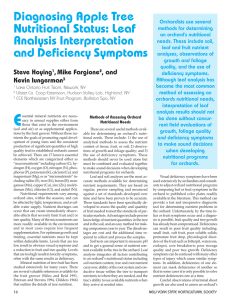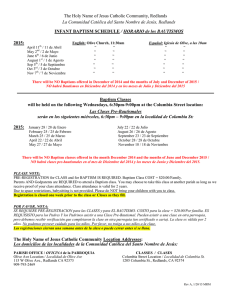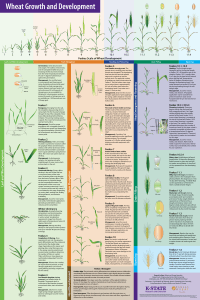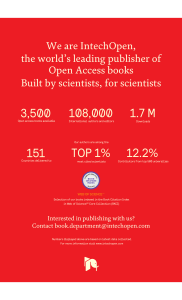Differences in leaves of olive trees under organic, integrated and
Anuncio
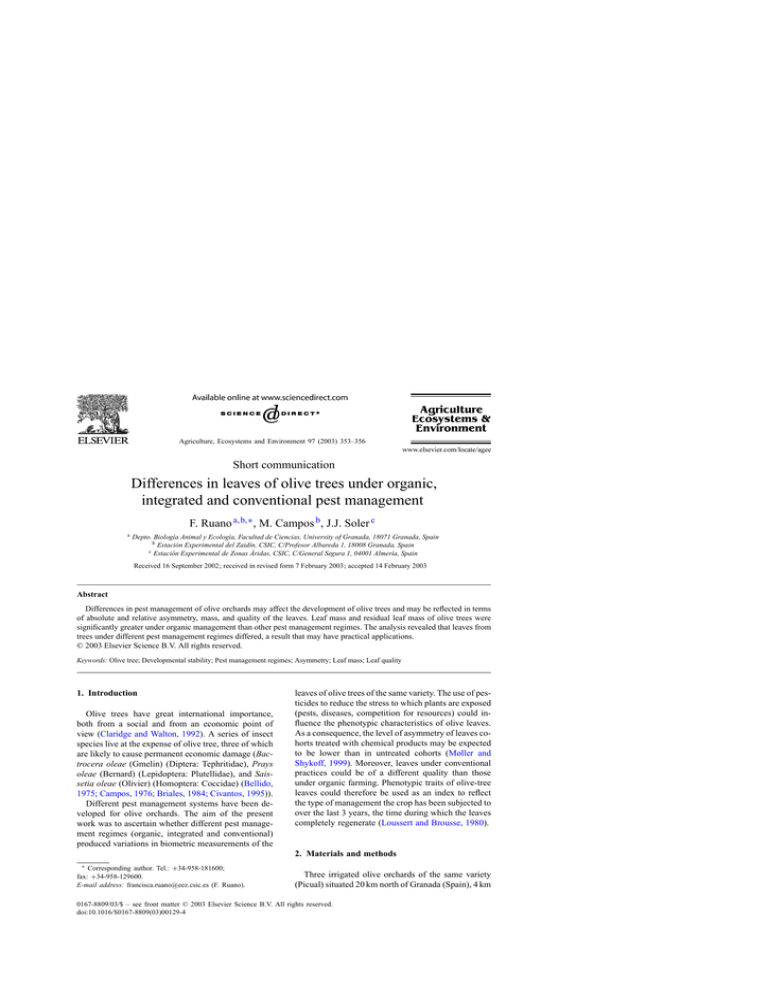
Agriculture, Ecosystems and Environment 97 (2003) 353–356 Short communication Differences in leaves of olive trees under organic, integrated and conventional pest management F. Ruano a,b,∗ , M. Campos b , J.J. Soler c a Depto. Biologı́a Animal y Ecologı́a, Facultad de Ciencias, University of Granada, 18071 Granada, Spain b Estación Experimental del Zaidı́n, CSIC, C/Profesor Albareda 1, 18008 Granada, Spain c Estación Experimental de Zonas Áridas, CSIC, C/General Segura 1, 04001 Almerı́a, Spain Received 16 September 2002; received in revised form 7 February 2003; accepted 14 February 2003 Abstract Differences in pest management of olive orchards may affect the development of olive trees and may be reflected in terms of absolute and relative asymmetry, mass, and quality of the leaves. Leaf mass and residual leaf mass of olive trees were significantly greater under organic management than other pest management regimes. The analysis revealed that leaves from trees under different pest management regimes differed, a result that may have practical applications. © 2003 Elsevier Science B.V. All rights reserved. Keywords: Olive tree; Developmental stability; Pest management regimes; Asymmetry; Leaf mass; Leaf quality 1. Introduction Olive trees have great international importance, both from a social and from an economic point of view (Claridge and Walton, 1992). A series of insect species live at the expense of olive tree, three of which are likely to cause permanent economic damage (Bactrocera oleae (Gmelin) (Diptera: Tephritidae), Prays oleae (Bernard) (Lepidoptera: Plutellidae), and Saissetia oleae (Olivier) (Homoptera: Coccidae) (Bellido, 1975; Campos, 1976; Briales, 1984; Civantos, 1995)). Different pest management systems have been developed for olive orchards. The aim of the present work was to ascertain whether different pest management regimes (organic, integrated and conventional) produced variations in biometric measurements of the leaves of olive trees of the same variety. The use of pesticides to reduce the stress to which plants are exposed (pests, diseases, competition for resources) could influence the phenotypic characteristics of olive leaves. As a consequence, the level of asymmetry of leaves cohorts treated with chemical products may be expected to be lower than in untreated cohorts (Møller and Shykoff, 1999). Moreover, leaves under conventional practices could be of a different quality than those under organic farming. Phenotypic traits of olive-tree leaves could therefore be used as an index to reflect the type of management the crop has been subjected to over the last 3 years, the time during which the leaves completely regenerate (Loussert and Brousse, 1980). 2. Materials and methods ∗ Corresponding author. Tel.: +34-958-181600; fax: +34-958-129600. E-mail address: [email protected] (F. Ruano). Three irrigated olive orchards of the same variety (Picual) situated 20 km north of Granada (Spain), 4 km 0167-8809/03/$ – see front matter © 2003 Elsevier Science B.V. All rights reserved. doi:10.1016/S0167-8809(03)00129-4 354 F. Ruano et al. / Agriculture, Ecosystems and Environment 97 (2003) 353–356 apart and at the same altitude (800 m a.s.l.), were studied. Trees in the orchards were 10 m apart, on and between rows. Orchard 1 was under conventional pest management with three insecticides (two in spring, one in autumn) and two herbicides (one in spring, another in autumn) treatments and mineral fertilization. Orchard 2 was under integrated pest management, with one insecticide (in July) and one herbicide (in March) treatments and mineral fertilization. Orchard 3 was under organic pest management and fertilization, without any pesticide application over the last 3 years. In November 2000, five randomly selected trees in each olive orchard were sampled. From the north side of each tree, secondary branches 30 cm long were collected 1.5 m from the ground. From the central shoot, 25 leaves were removed at random, clipping one of each pair of opposite leaves until reaching the growth zone, which was discarded. The following variables were measured; leaf mass (Mettler AE 240, 0.1 mg accuracy), thickness at the center and at both sides of the central rachis (Mitutoyo, thickness gauge 547–315, 0.1 mm accuracy), length up to the petiole, and asymmetry across the center of the leaf (Digimatic Indicator IDC series 543 Mitutoyo under a Leica MS5 10×/21B binocular microscope). Measurements were made twice several days apart by the same person. Leaves were kept refrigerated and the following variables were analyzed: fresh leaf mass, residual leaf mass (i.e., difference between the observed values of leaf mass and the corresponding fitted values predicted by the regression line with leaf length), leaf length, absolute and relative asymmetry (i.e., absolute asymmetry divided by the size of the character). All the measurements were highly repeatable (P < 0.001). All variables approaching a normal distribution, parametric tests following Sokal and Rohlf (1995) were used based on mean values of leaf measurement Fig. 1. Differences between pest management regimes expressed in terms of leaf mass (A), residual leaf mass (B), absolute (C), and relative asymmetry (D) of the leaves (±S.E.). F. Ruano et al. / Agriculture, Ecosystems and Environment 97 (2003) 353–356 355 Fig. 2. Olive trees under three pest management regimes plotted according to two canonical axes based on mass, residual leaf mass (difference between observed and expected value of leaf mass as predicted by the regression line with leaf length), and relative asymmetry. per tree to avoid pseudoreplication. When comparing leaves from orchards under different pest management regimes a two-factor nested MANOVA was used where tree was considered a random factor nested within zone. Differences between pest managements were estimated by LSD post-hoc comparisons, all tests being two-tailed. A discriminant analysis using mean values per tree of the variables described above was used to distinguish between pest managements. 3. Results and conclusions Leaf mass of olive trees was significantly greater under organic than other management types (Fig. 1A), the factor “pest management” explaining almost twice the variance (21.22%, F = 7.58, d.f. = 2, 12, P = 0.007) explained by the factor “tree” (13.52%). With respect to the residual leaf mass, the results were very similar (effects of factor “pest management”: F = 5.44, d.f. = 2, 12, P = 0.021), with high values for leaves of olive trees under organic pest management (Fig. 1B), low values for integrated pest management. The factor “pest management” (22.24%) explained a percentage of variance similar to that explained by the factor “tree” (22.83%). Neither relative nor absolute asymmetry differed between organic and integrated pest management, whereas they were lower under conventional pest management (Fig. 1C and D). The percentage of variance explained by “pest management” was higher (2.15%) than that explained by the factor “tree” (0%). The above results suggest that trees under different pest management may be distinguished based on morphological characters of the leaves. A discriminant analysis resulted in two canonical axes (standardized coefficients for mass, relative asymmetry, and residual of mass leaf; Root 1 (eigenvalue = 2.60): −1.09, −0.78, 0.24; Root 2 (eigenvalue = 0.80): −0.32, 0.15, 1.14) discriminated between pest management (Wilks’ Lambda: 0.15, F6,20 = 5.16, P < 0.0024) and correctly classified all trees except one in the organic orchard (Fig. 2). These results show that using leaf traits to distinguish between pest management regimes of olive orchards could have practical applications. Acknowledgements Carlos Lozano, Herminia Barroso and Luis Alfonso helped during the time-consuming measurements; the Grupo de Etologı́a of the University of Granada lent the thickness gauge. Arancha Peña lent the balance. David Nesbitt corrected the English version of the manuscript. Jose Luis Romero, Manuel Recio and Saturno Abril permitted access to olive orchards 356 F. Ruano et al. / Agriculture, Ecosystems and Environment 97 (2003) 353–356 and facilitated our work there. This study was financed by Project CICYT AMB98-0946 awarded to M. Campos and ACC53CVI-2001 to J.J. Soler and M. Campos. References Bellido, L., 1975. Contribución al estudio de Prays oleae Bern (Lep. Hyponomeutidae) en Córdoba. Tesis doctoral. Univ. de Córdoba. Briales, M.J., 1984. Contribución al estudio bioecológico de Saissetia oleae (Oliv.) (Homoptera, Coccoidea, Coccidae) en Granada. Tesis doctoral. Univ. de Granada. Campos, M., 1976. Contribución al estudio de la entomofauna del olivo en España. Observaciones bioecológicas sobre Prays oleae Bern (Lepidoptera, Hyponomeutidae). Tesis doctoral. Univ. de Granada. Civantos, M., 1995. El desarrollo del control integrado en el olivar español. Olivae 59, 75–81. Claridge, M.F., Walton, M., 1992. The European olive and its pests-management strategies. BCPC 52, 3–12. Loussert, R., Brousse G., 1980. El Olivo. Ed. Mundi-Prensa, Madrid. Møller, A.P., Shykoff, J., 1999. Morphological developmental stability in plants: patterns and causes. Int. J. Plant Sci. 160, 135–146. Sokal, R.R., Rohlf, F.J., 1995. Biometry: the principles and practice of statistics in biological research. Freeman, New York.
